So, let´s start our traditional annual Boot Duesseldorf retrospective with a true highlight of the show: KM Yachtbuilders´Bestevaer 54 MIC MAC. I am starting with that yacht because she really catched my imagination from the onset: This is a boat you instantly want to be out there in the high latitudes, preferably the Arctic or Antarctic, and just … get caught by the ice and frozen. I really mean it: If I´d had to choose any boat in which I wanted to have an overwintering with, it´s the Bestevaer.
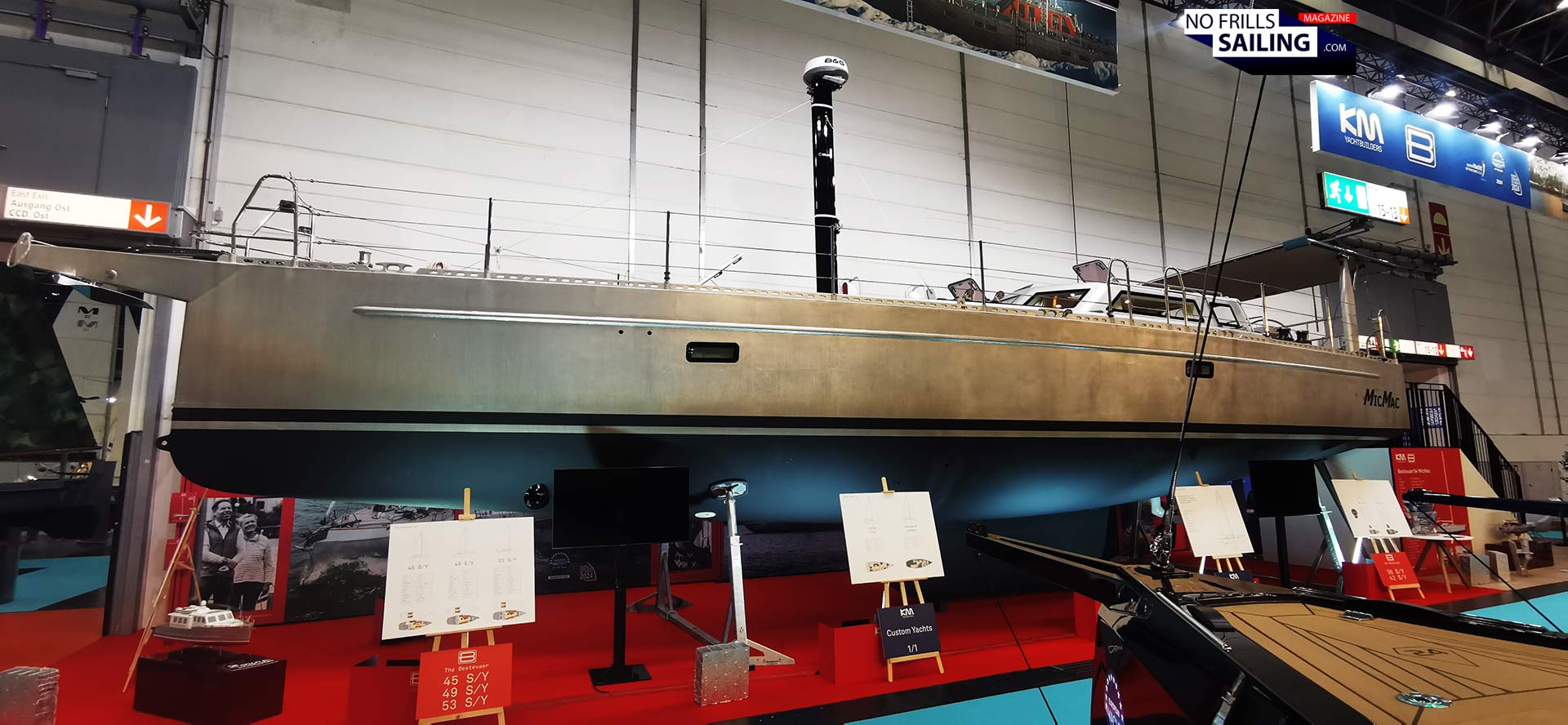
I would say that the Bestevaer by Dijkstra-design and the Exploration by Garcia Yachts are the two big names synonymous with high laitudes-sailing, ice-proof hulls, winter-capable yachts. Rugged, massive, strong: Bulletproof sailing. Whereas the Garcia Exploration with her modern lines and style appeals to the more contemporary taste, other sailors prefer the classic cutter lines of the Bestevaer. A ship which could easily fit back into Sir John Franklin´s times as well as into our 21st Century.
A dream-enabler …
In this, I climb the ladder to enter the yacht just half an hour before the boat show is open to the publick. Her massive, clean stern with a small „bathing“ platform is completely enclosed: Like a barrier against aggressive polar bears or piled up sheets of ice. It´s really easy to completely forget the world around me, endulging myself into this antarctic daydream – the Bestevaer is like a Dreamcatcher.
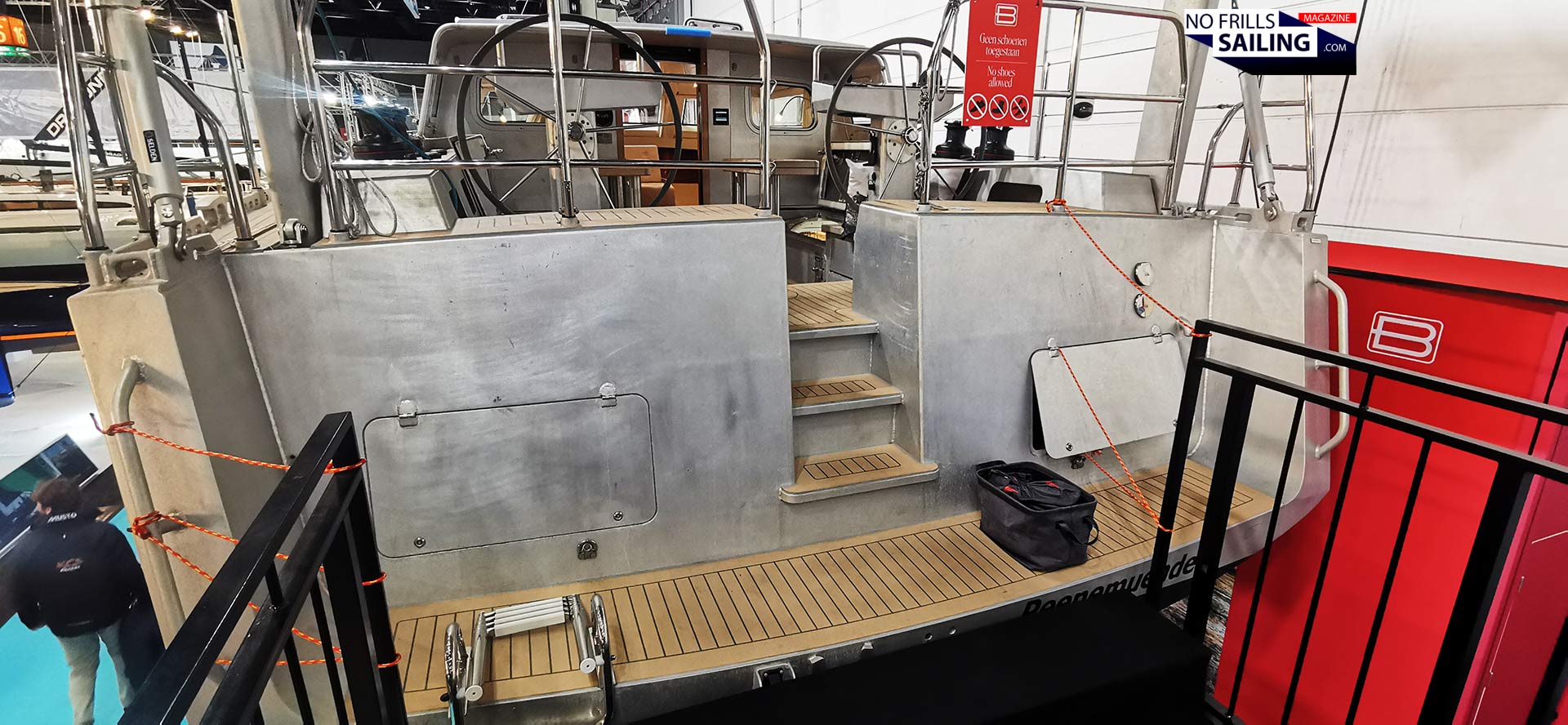
Her flat bottomed hull is kind of surprising: Yes, she displaces some 20 tons which is massive for a nearly 17 meters long yacht. For comparison, the Exploration 52 by Garcia has a similar weight, 500 kilograms short. The Beneteau Oceanis Yacht 54, a thorough Mediterranean-style family cruiser will weigh in just 16.6 tons. Nevertheless, the lines of the Bestevaer´s hull look fast, a nice flat stern tearing edge. Just as if she was able to start planing mode at any moment. Which, of course, may only be possible when she´d running downwind before a string storm, surfing freak waves.
KM Yachtbuilders: Highest possible craftsmanship
I don´t get aboard but instead roam around the hull at first. When opting for an aluminium yacht, and interested future owner will most certainly have to look twice when it comes to the hefty price tags. Making an aluminium hull requires much more efforts and highly skilled craftsmanship than laminating a GRP-hull. KM Yachtbuilders have an unspoiled track record of manufacturing spotless aluminum round chine hulls.
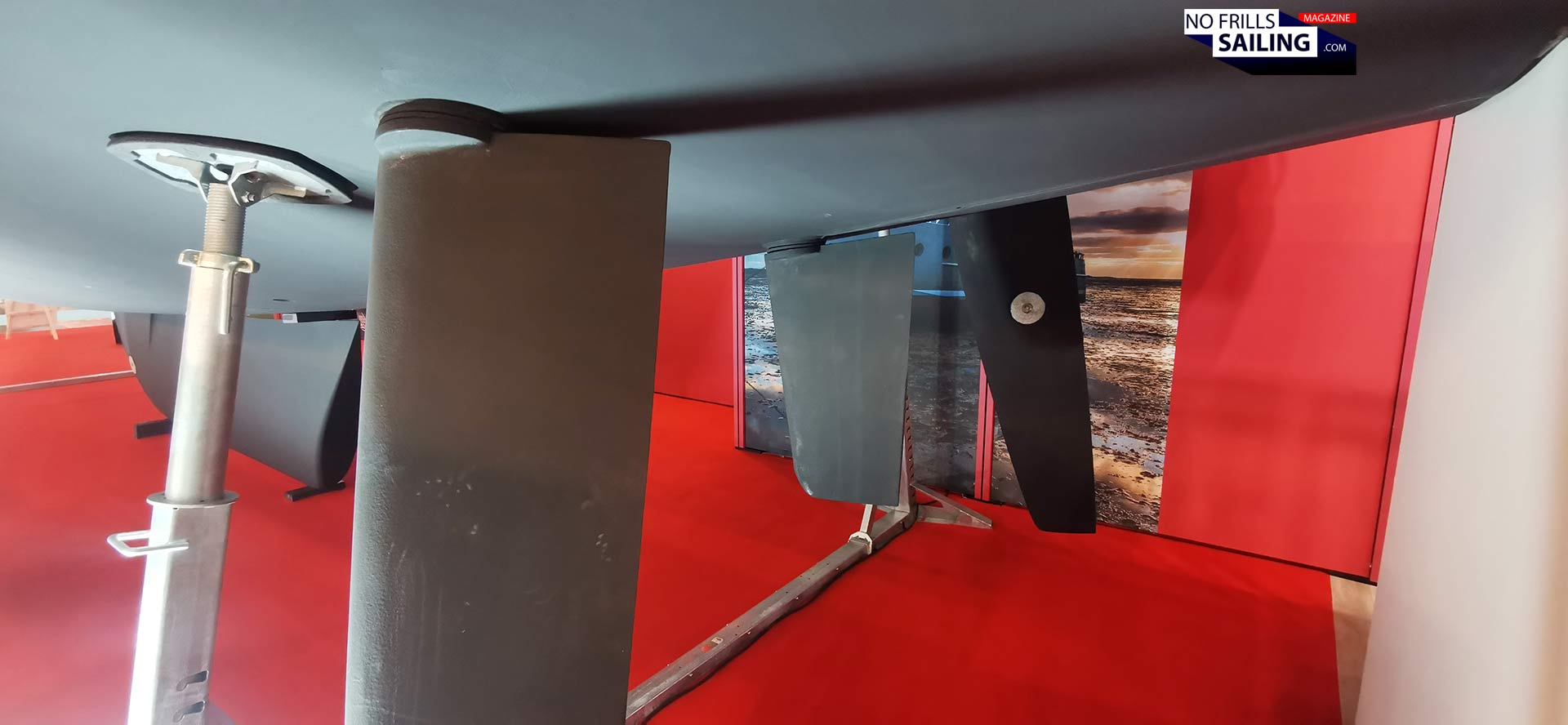
This is clearly visible when looking at her nicely shaped underwater body: To save costs other brands like Boreal or Alubat chose the hard chine-approach. The curvature of the hull is reduced to five, sometimes six, „planks“ which run from bow to stern. In this, the classic and new Alubat Ovni for example made aluminkum yachts slightly more affordable by reducing much of the labour-costs making the hulls. Hard chined-hulls in relatively slow sailing boats don´t make much of a difference, they say, but surely, a soft perfect round underwater body is preferable.
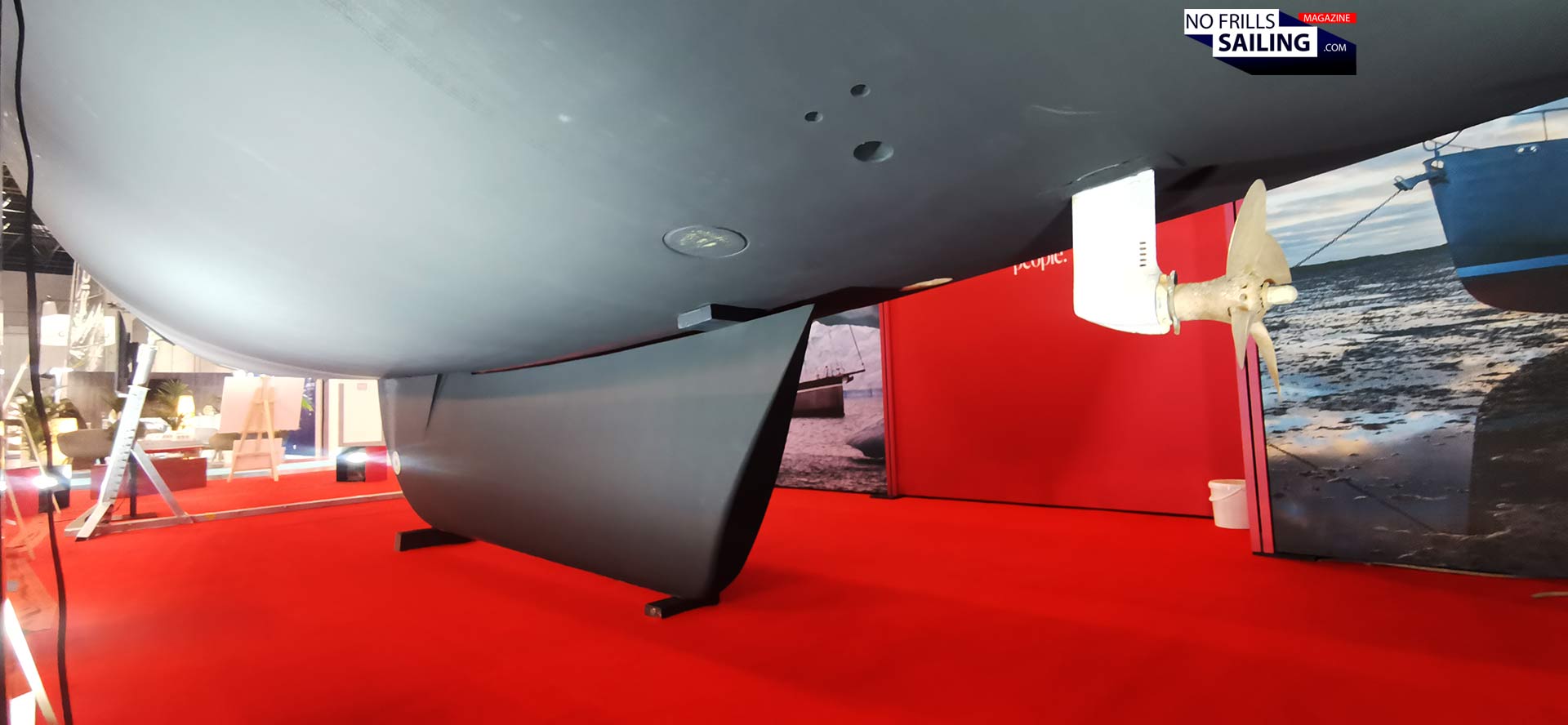
The Bestevaer 54 MIC MAC sports a swing keel and has a three rudder blades-configuration. When investing in an „exploration“-type sailboat, having variable draft is an absolute must in my opinion: It enables you to crawl deep into coves and bays to seek shelter from hazardous weather and you can even sail upriver to explore more inland. MIC MAC therefore can also dry out without any problems. Note how beautifully the trailing edge of the swing keel is made to cuddle seemlessly onto the hull shape. So much love and dedication in these details …
Rugged & designed for the “hard” cruises
On the other hand, this yacht surely can take a beating! As I step aboard I go to the foredeck and admire the simple, functional and kind of „brutal“ looking doghouse of the boat. The designers made no efforts at all to disguise it´s ruggedness and function. You can make it look nice and beautiful, like Boreal has done it so admirably, but that´s not the „theme“ of this yacht: MIC MAC makes it clear from the outset – bring it on, I can take it!
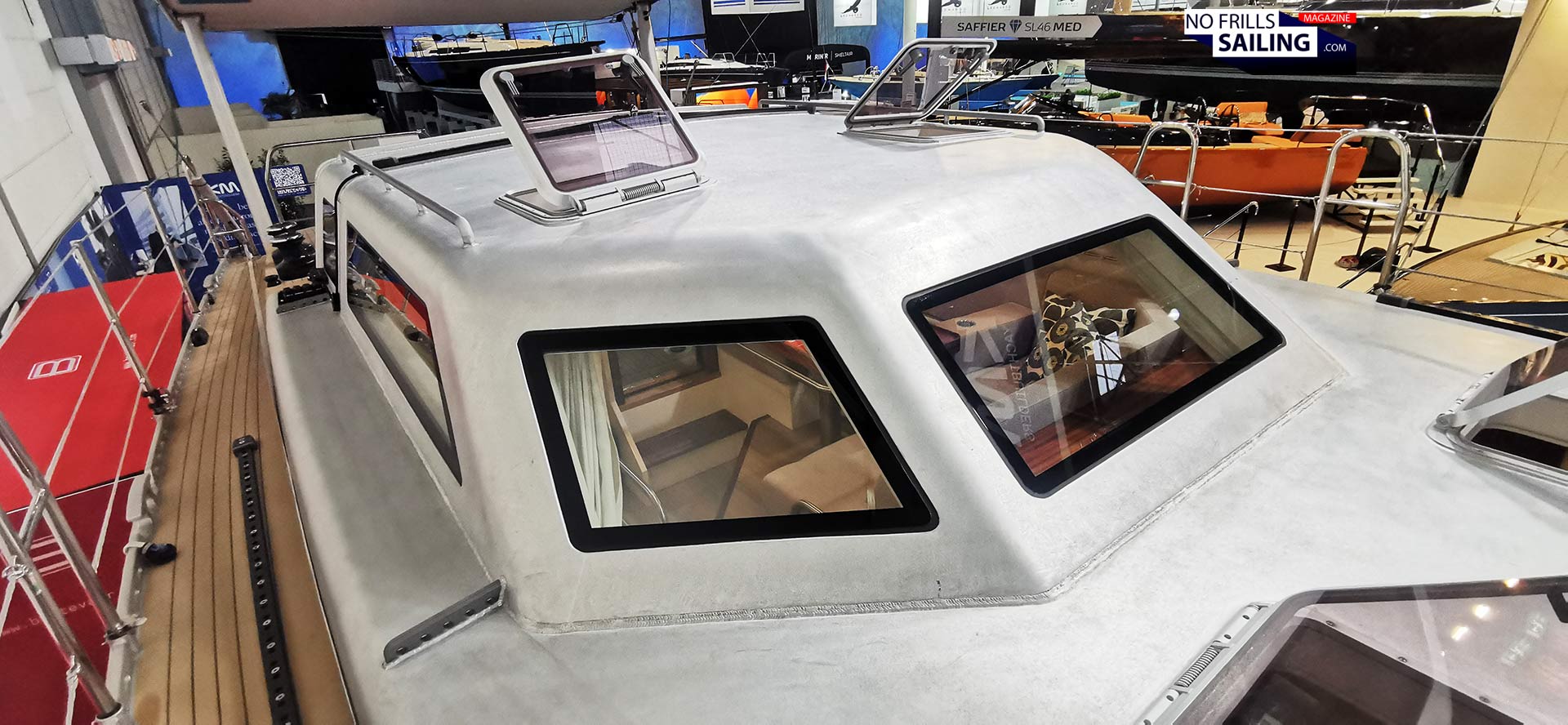
Standing at her bow, looking back, it is quite obvious that „being beautiful“ or currying favor was not part of the owner´s briefing to the shipyard. The Bestevaer´s appearance is the essence of functionality: At least seen from the outside. Clear lines, subjugated to the purpose without any frills or useless decorations. A boat like a tug: Made for a purpose, not to be admired. It is this clean, honest approach, I like the most about her design.
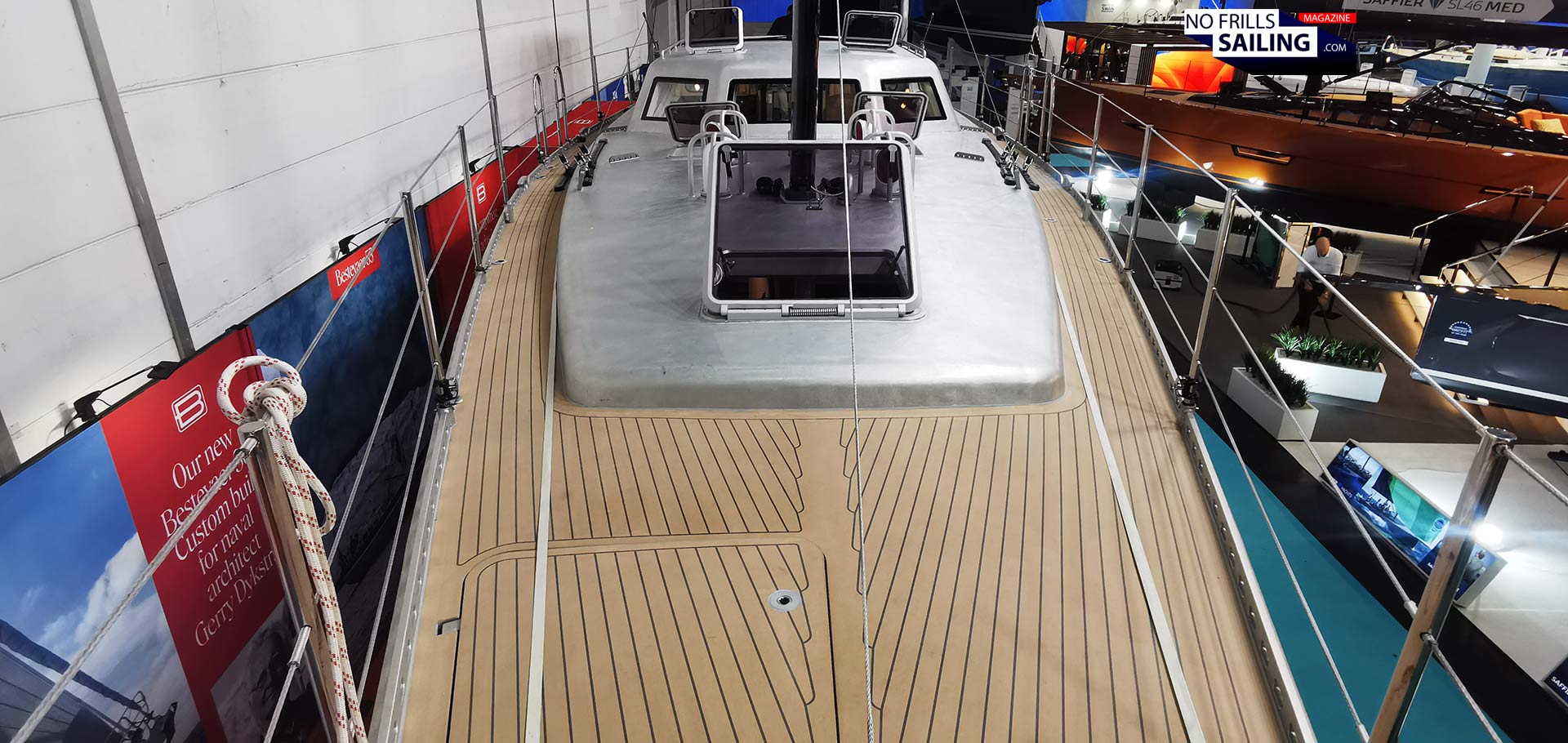
This approach certeinly finds its fans: KM Yachtbuilders is not the loudest brand in the market. Their marketing is humble, kind of moderate, almost „hidden“. Nevertheless, when I come across social media postings about ships entering the Arctic or Antarctic, chances are high that those boats have been made in the Netherlands by KM in Makkum. In any case, the Bestevaer is far from being just a massive tank for tackling the Growler-infected waters of the far North and South.
It´s in the details
The boat is littered with seemingly little details which will make the boat connoisseur smile. The fresh air ventilation for example. I was kind of „shocked“ a bit when I visited Hallberg-Rassy´s new flagship last year and saw that plastic air-vents had been installed there. I mean, those plastic parts may work perfectly fine and do their job … but they look kind of cheap, at least to me. That´s something you won´t see on the Bestevaer:
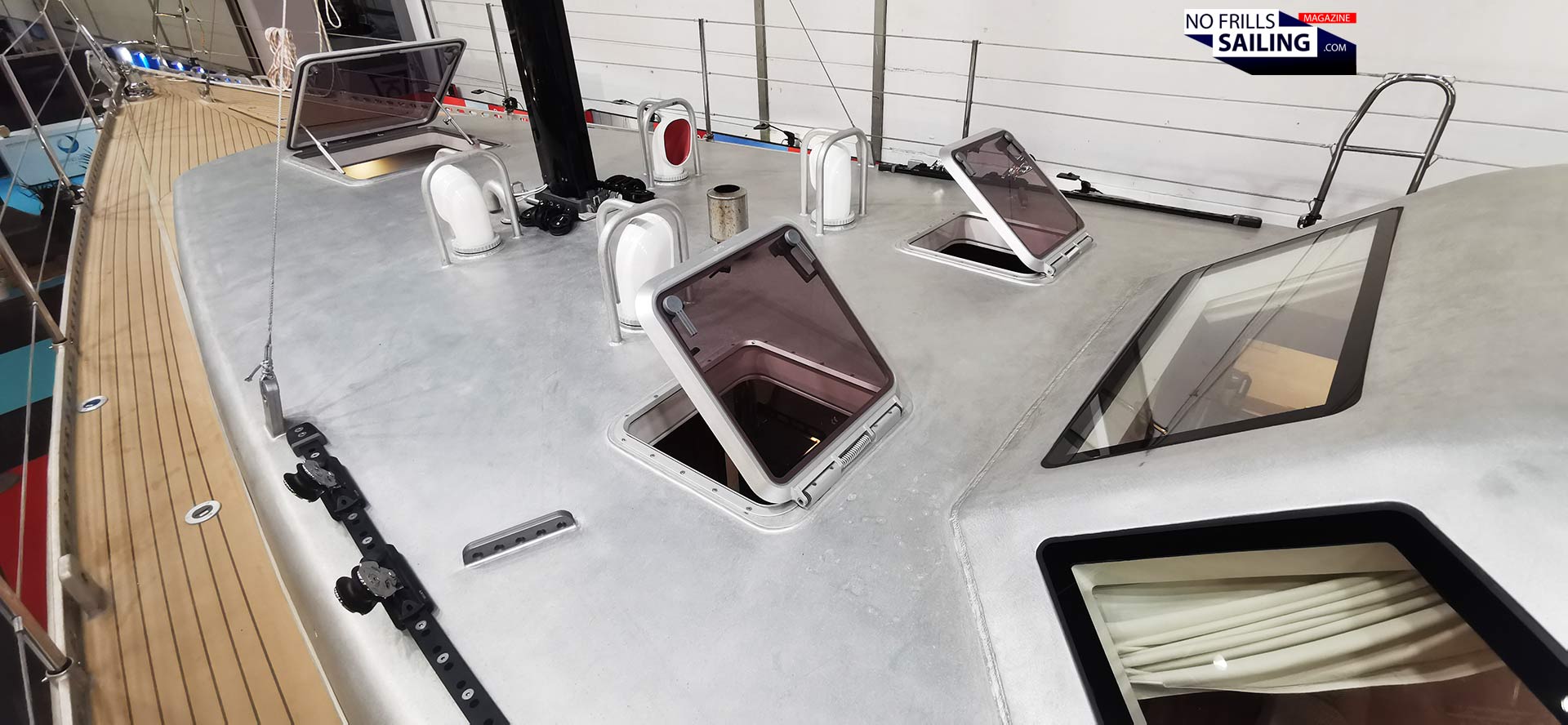
Classy, nice Dorade-type ventilators. Four of them mounted on the coachroof. These will be moved by the wind to face the openings to leeward, making for a constant stream of fresh air. Doreade ventilators are spray water proof and safe – apart from their long proven functionality, they look absolutely awesome, classy, perfectly fitting the overall style of MIC MAC. Protected by an aluminium cage, another functional detail that I like.
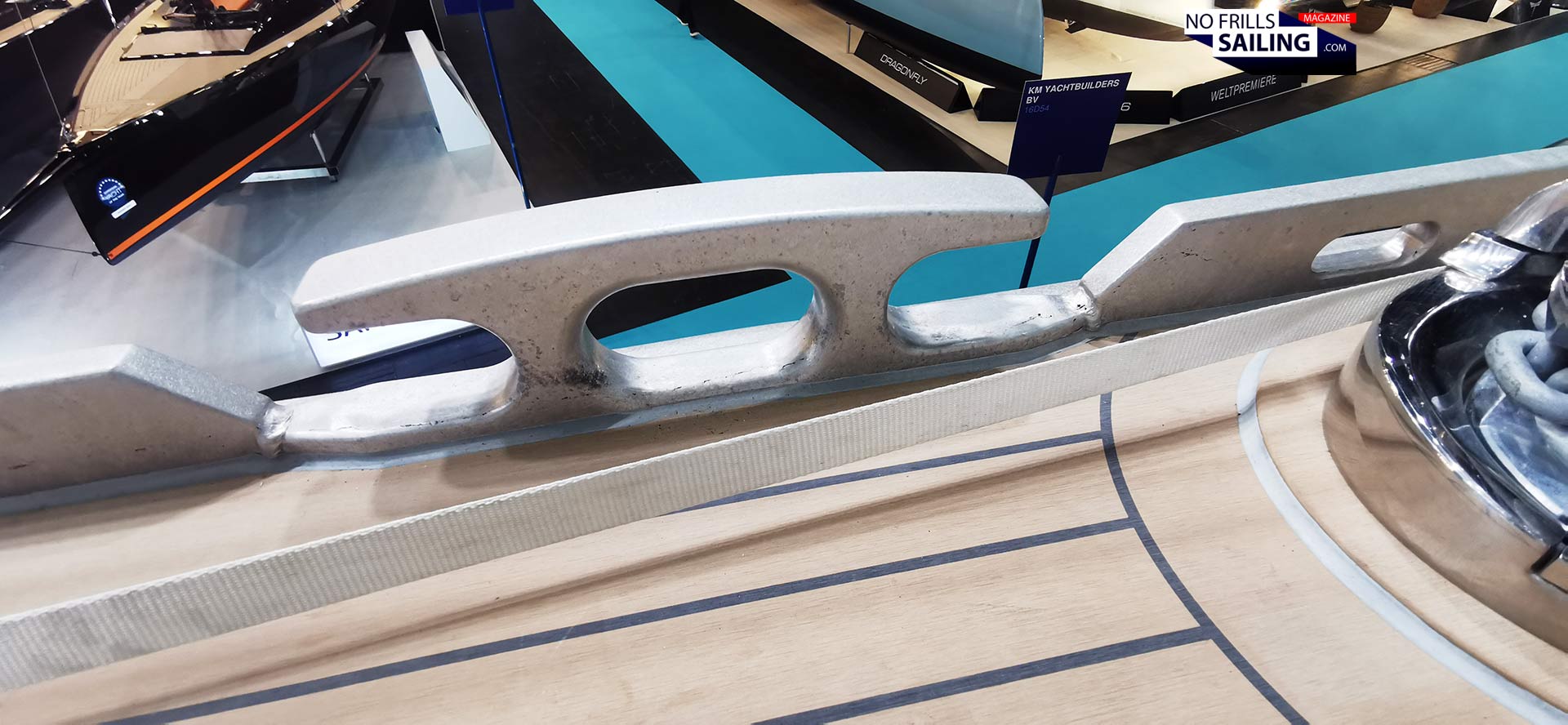
Another detail I like is the clamps. KM Yachtbuilders could have just fitted pre-fab clamps or come up with simple solutions. Instead, the Bestevaer 54 sports nicely rounded, perfectly shaped custom made dog-irons for the mooring lines, whoch is an effort only the classicist will note and honor. It is good to see that apparently the owners of MIC MAC – in this case fellow German sailors – had approved spending money and working ours for making these, instead of saving on this detail. This yacht is built to sail to the extreme ends of our planet. Therefore, safety is of utmost concern of course. The railing is equipped with three rails instead of two and is a bit higher to ensure safety of the people on deck. There are grab handles all along the side and backside of the doghouse.
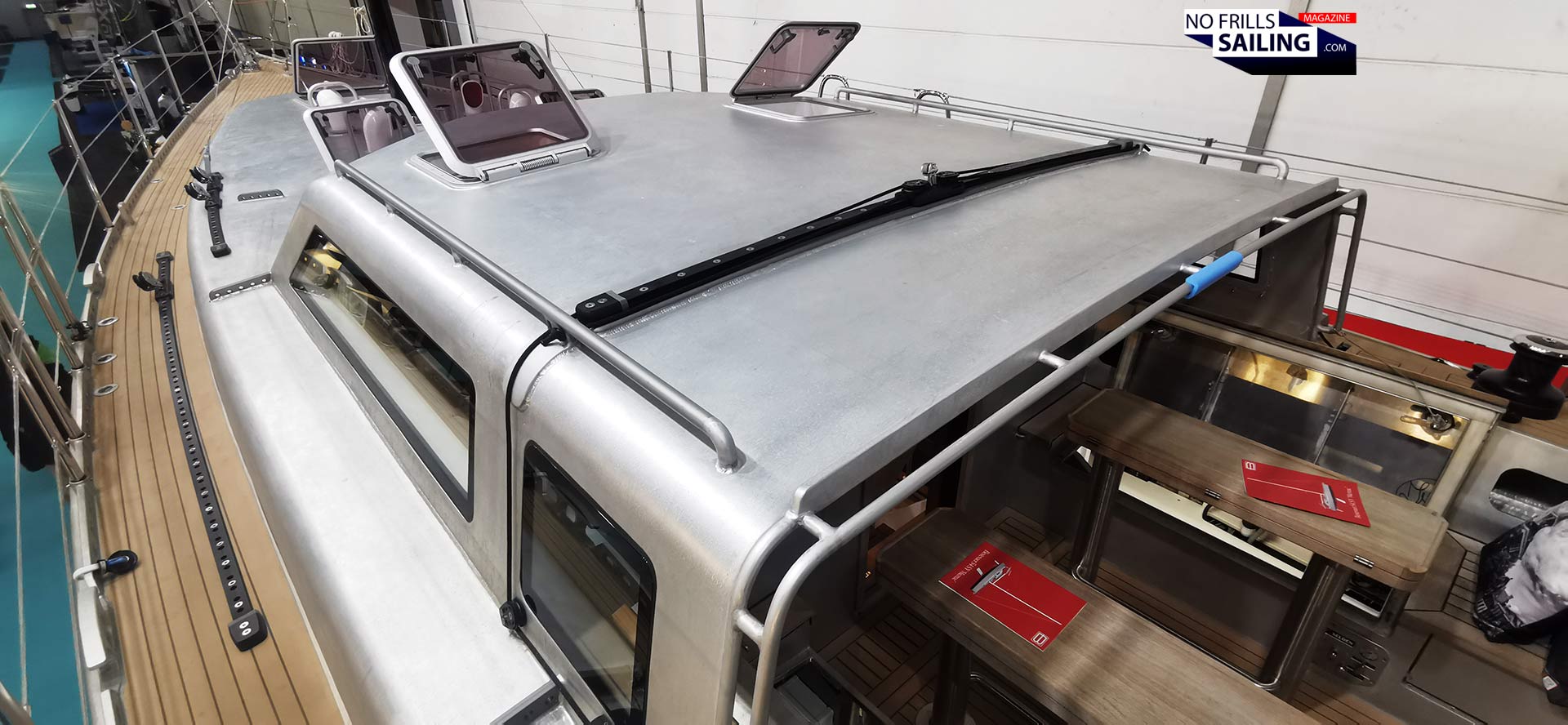
I only kind of missed some granny bars at the mast foot but I guess due to the fact that all of the running rigging is diverted back into the cockpit, there is just no need to regularly go to the foredeck and secure a crew member. So, what do you think? Can you envision yourself packed into the warmest functional clothing, standing in the cockpit of a boat like this, the opening of the Hudson Strait on the bow, Resolute Island to your starboard side? I can!
In the cockpit of the Bestevaer 54
Speaking of MIC MAC´s cockpit. Again, function triumphs over form. Everything has its purpose here, no frills, no decorations. The steering posts are simple, straight-lined and rugged, as the boat. The owners went for B&G electronics and push-button-sailing when it comes to the winches. Two small cockpit tables with folding tops create at least some comfort when weather permits an outside-dinner.
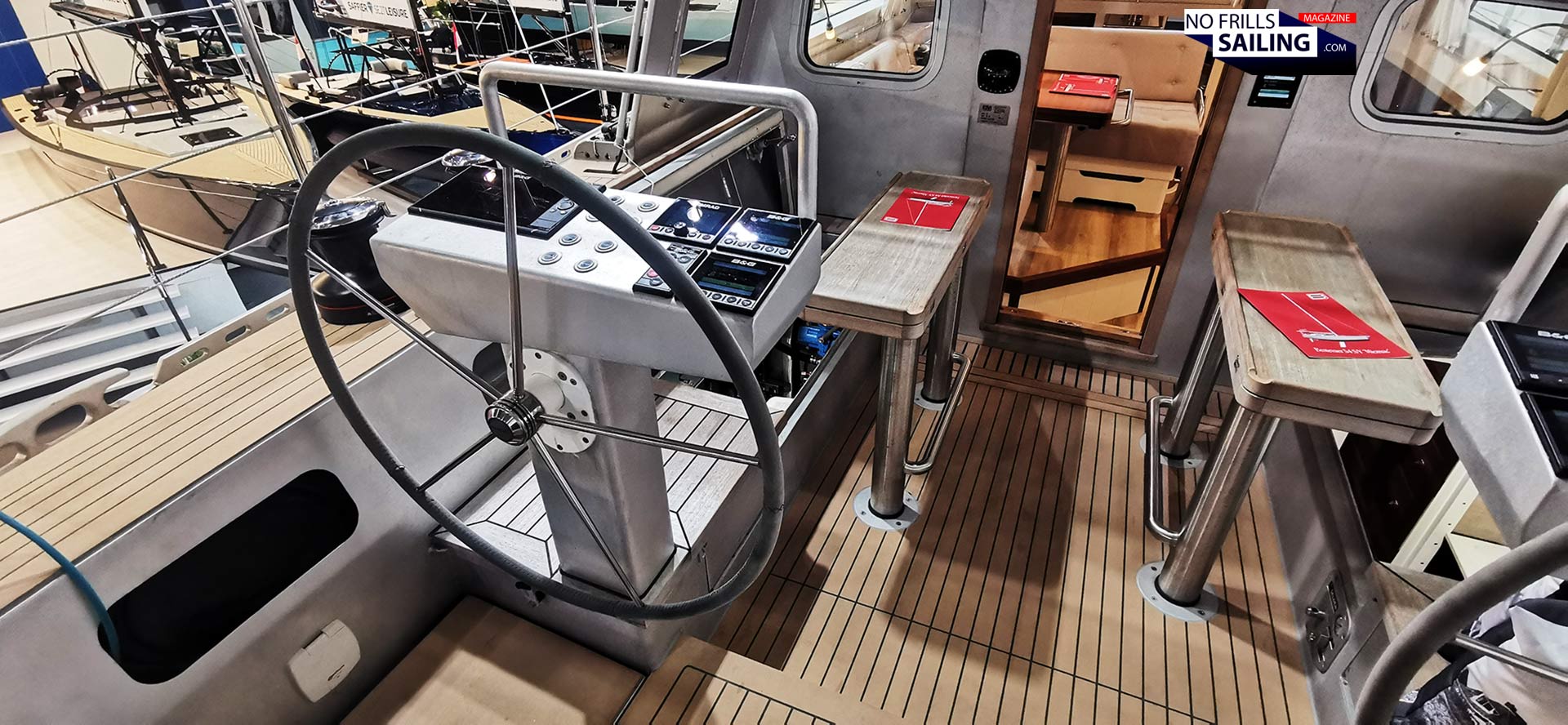
All winches on this Bestevaer are electrified, which makes sense: Boats like these need a large sails area to be powered up to cruising speeds. Also, sailing in extreme latitudes is often accompanied by very high wind speeds, sometimes storm force, which also put high loads on the sheets: You don´t want to crank the winch handle to trim your sails here! The winches can be controlled whilst standing up behind the steering posts or at the winches directly.
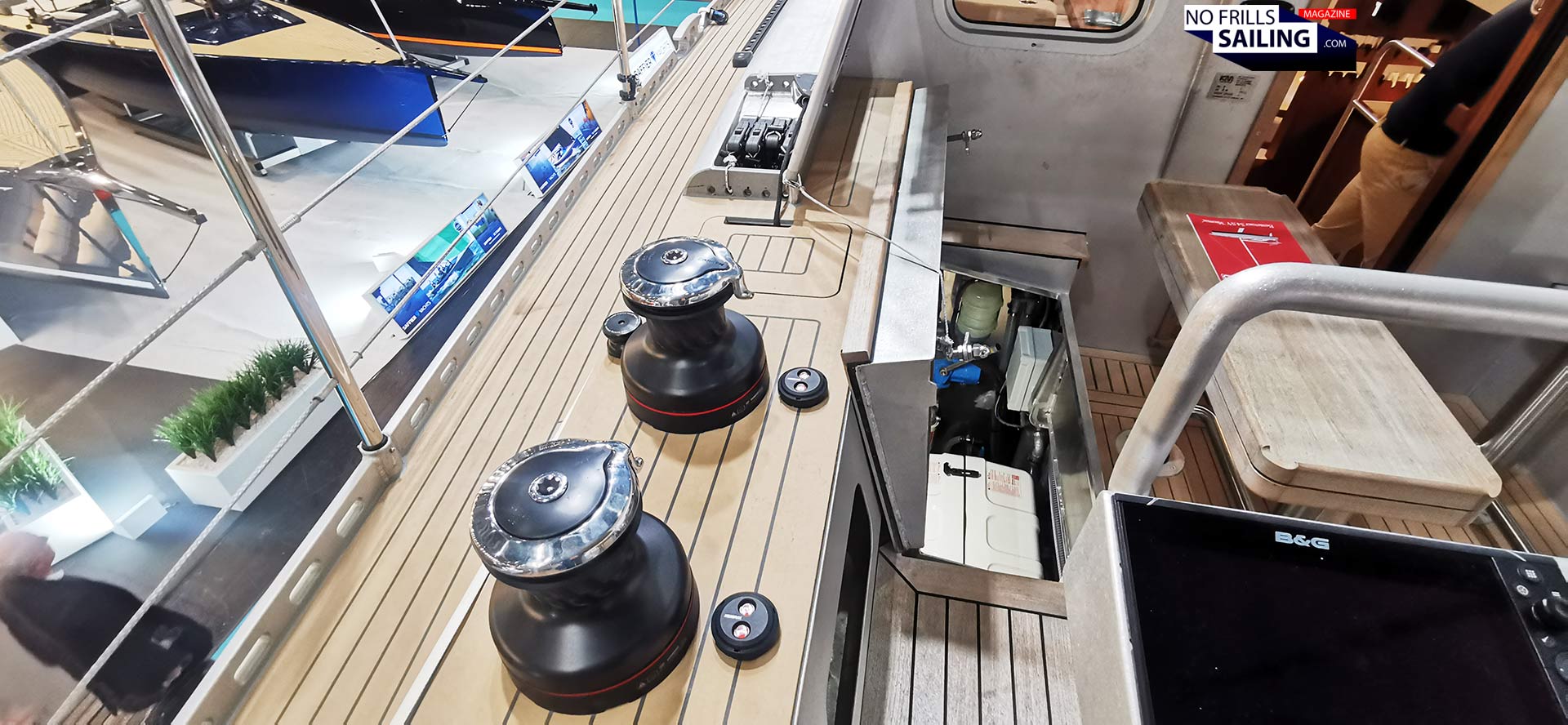
The only thing I asked myself about the winches was the positioning of the aft Genoa-winches directly in line with the working winches. To me it seems that I would have put the forward working winches a bit offset to the inside to let the lines going backwards to the Genoia-winches pass by the forward winch. Maybe there´s a reason for this though. A pretty ingenious detail is the multifunctional equipment rack:
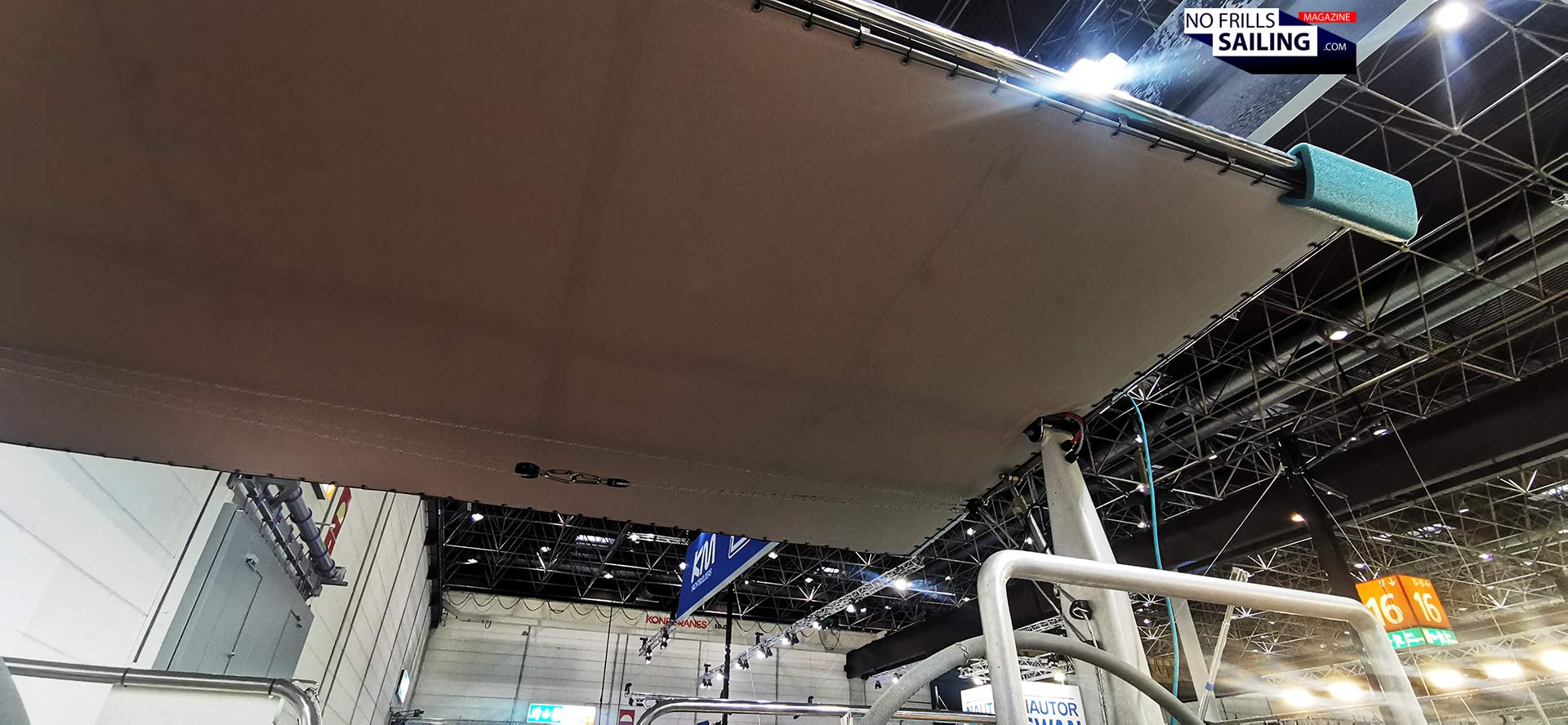
This features a large solar panel that has been nicely covered on its underside. The rack also functions as a davit for the small dinghy. But the nice thing is that the panel can be moved both aft and forward by hydraulic actuators. It therefore can be used as a sunshade/bimini and adjusted to the sun´s position. Again, a nicely detail and very innovative.
Save the best for last: Welcome down below …
Now that you´ve seen the Bestevaer 54´s outside appearance, let´s step aboard. Obviously, her doghouse is the central socializing area of the boat. Its large volume houses a very rich, thickly cushioned and cozy U-settee around a large folding table. The doghouse is on the same level as the cockpit so that sitting here offers a great 360 degrees all-round sight.
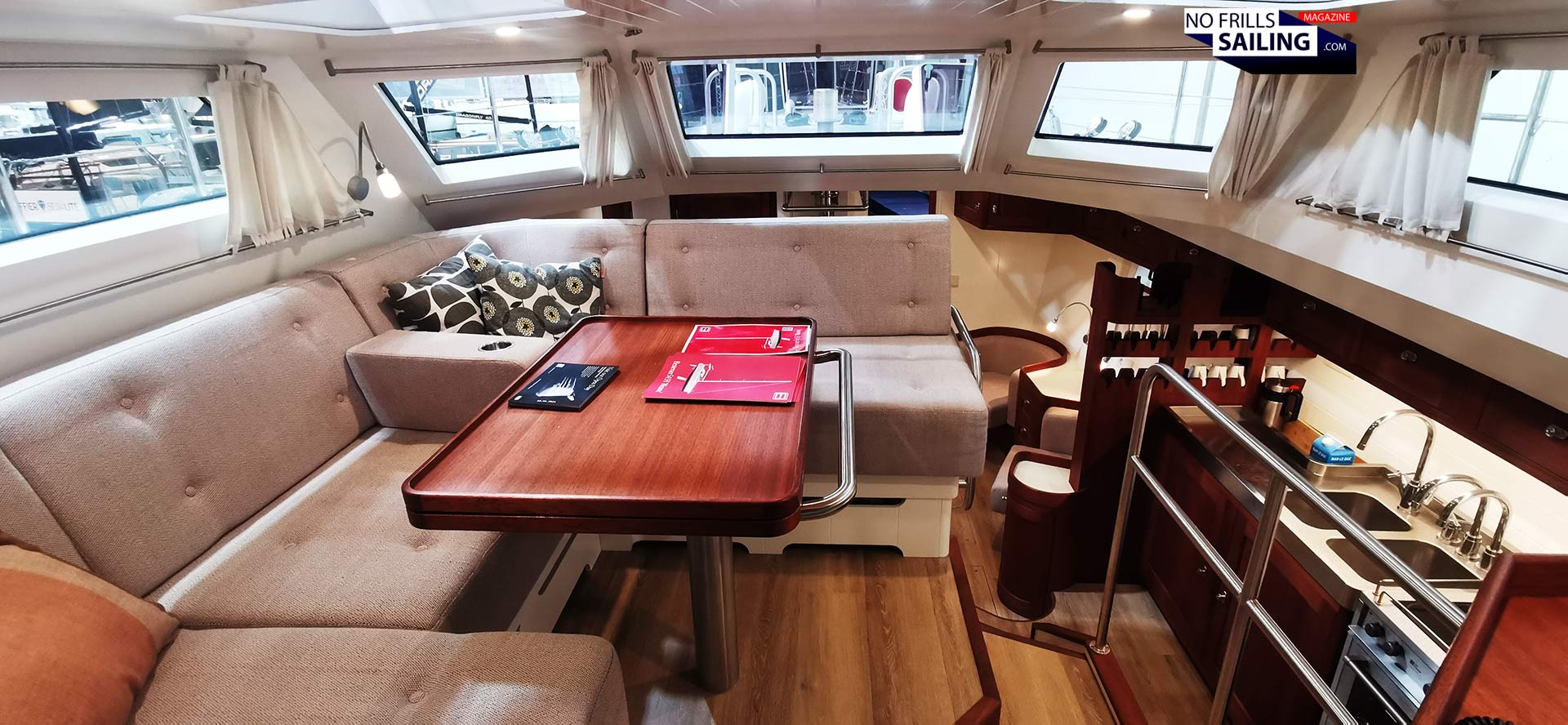
Just imagine being at anchor off Prince Charles Island in the Northwest Passage, thick packs of ice float by, the sun is barely up and you enjoy a nice fresh hot cup of tea … looking outside through the thick insulated windows. Isn´t that what we are all looking for? The doghouse can be cordoned off by pulling the curtains and may also function as a second bridge for the skipper´s watch when it is too rough or cold outside.
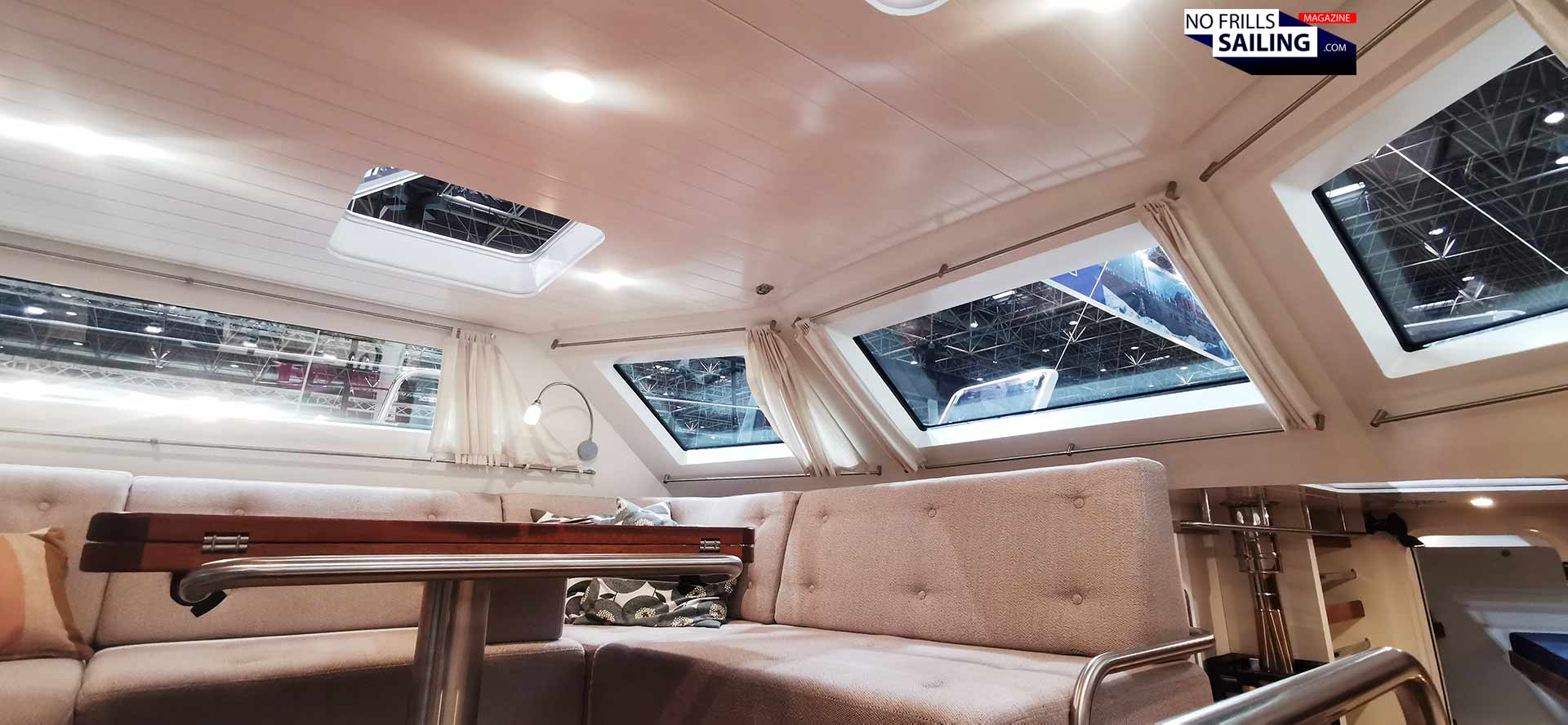
Therefore to the right hand side a „standing“ navigation station with a small chart table and all secondary electronic equipment is prepared. I like the approach here to reduce this station to the core elements: Displays, controls, a small working area – but no seat, no „waste“ of precious interior volume for a rarely manned place.
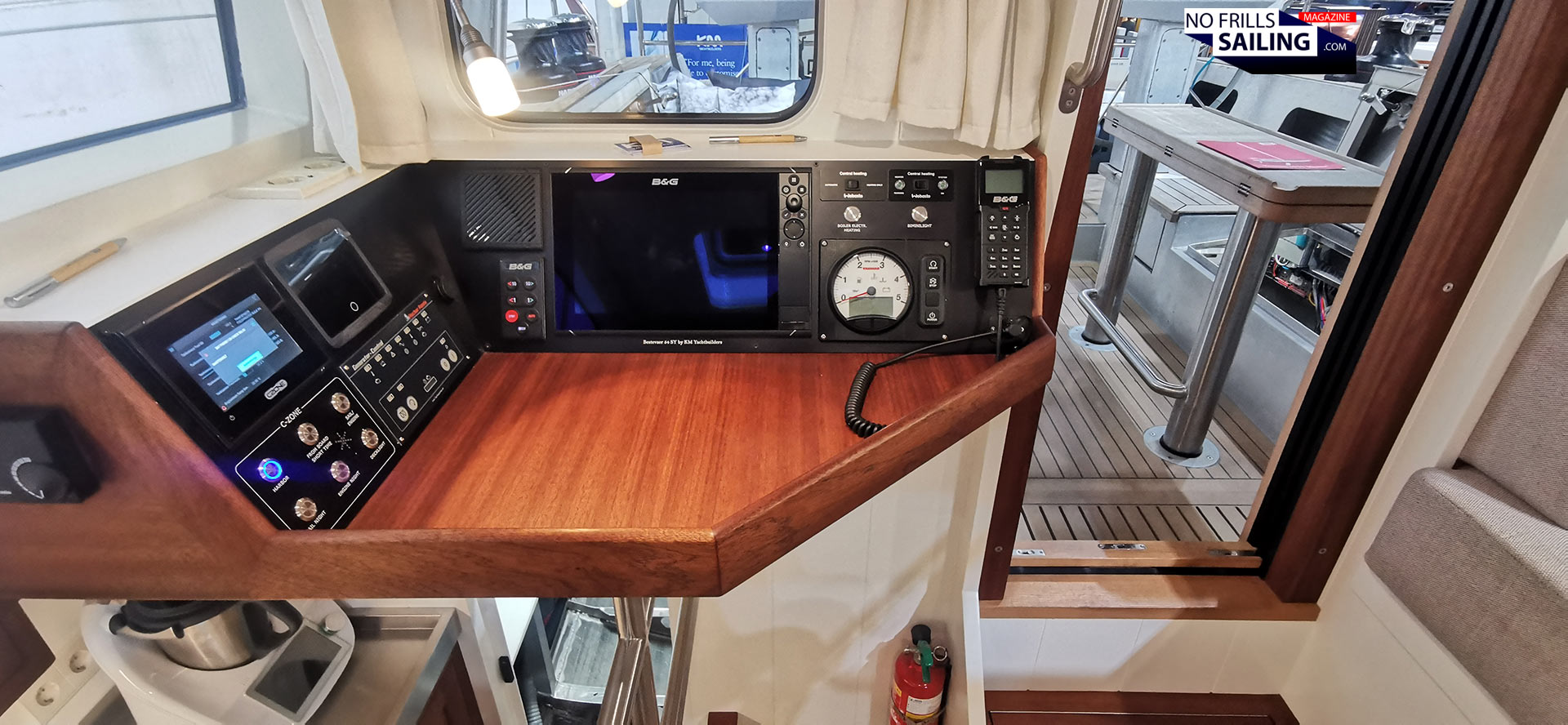
The boat can be controlled solely from this station, but apparently the owners know that this would he happening so seldom, that there was no need to design a full-fledged nav-station with Gecko-seat and all sorts of frills. In the case of MIC MAC, the users rather utilized the space for more comforts. I like this: On my Omega 42 there will also „just“ be a main switch panel, little work-top and no seat at the nav-station.
Full custom: The „open ship“ interior layout for MIC MAC
Many boats I´ve seen are kind of „closed“. Their areas are well separated. It often makes for a „compartmented“ and kind of cramped feeling. In cruising yachts this is due to the fact that most Mediterranean yachts are sailed by a couple with family-members or friends. That requires privacy and as such closed-off areas. Not so with this yacht: Belonging to a single sailing couple, apperently, they went for exactly the opposite interior design approach.
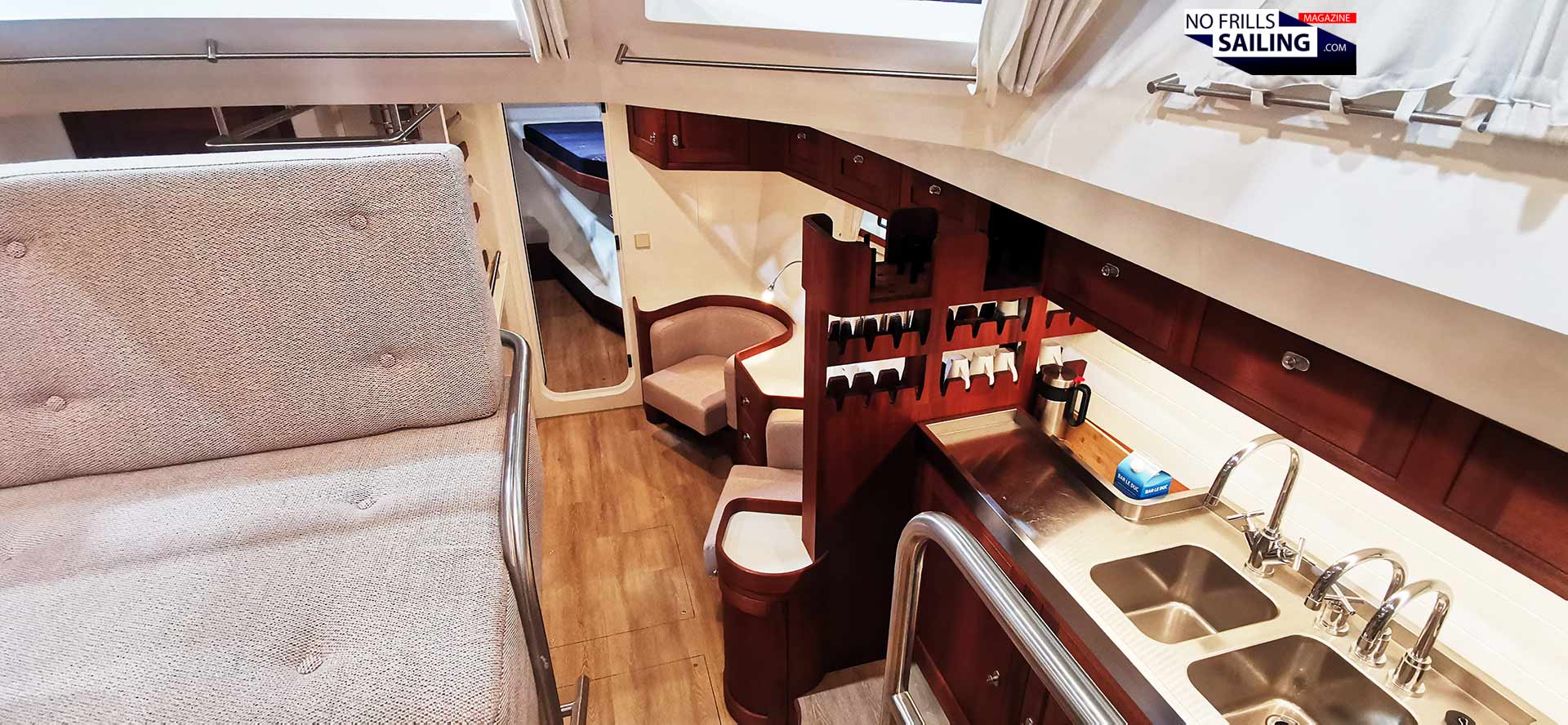
Everything is open. There are no doors, no bulkheads, no destinct cordoned off areas. Standing inside the doghouse, the view down below is not hindered by any of these. More so, the boundaries of each area, be it the galley or the berths, are fluent. Clearly, the owner-couple doesn´t like to open and close doors all day. The interior is designed to fit the intimacy of a couple sailing alone.
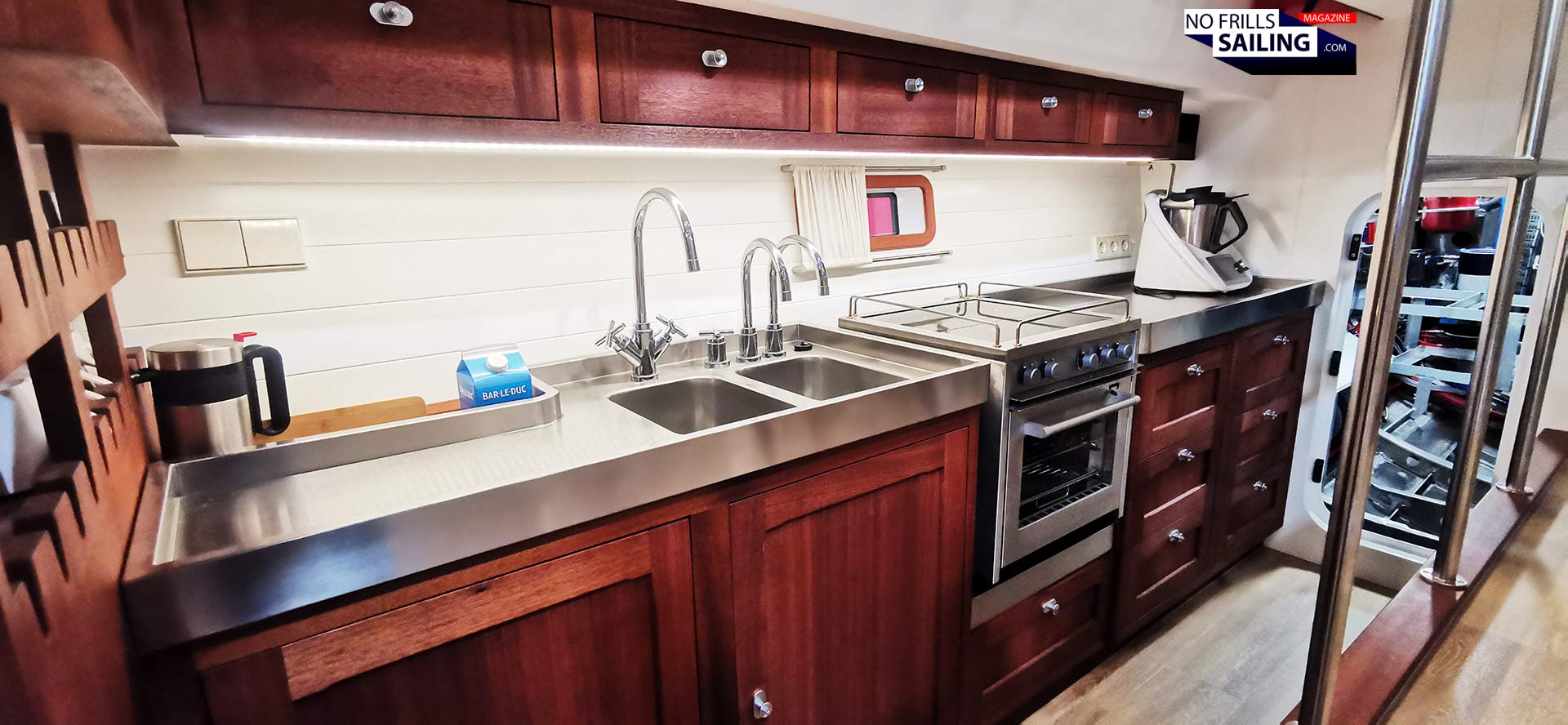
Going down a few steps, to starboard side, a large longitudinal kitchen is situated. All-electric appliances (apparently, there is abundant 230 Volts-power thanks to a gen-set), stainless steel worktop. Simple, clean, functional. I like the „grabrail“ or flooding-walls of the worktop-area around the sink and cooking place, preventing water or fluids from spilling onto the floor. Nice detail. The dark tinted wooden facings of the galley match the light-colored boat´s interior.
Aluminium eyecandy
Backwards, from the galley, a thick watertight door opens up into the rear engine room. As I am in full boat show dress, which means I weat suit and tie, I cannot crawl deeper into that area, but from what I can see, again, I am fully convinced that aluminium is the best material for a yacht sailing in extreme conditions.
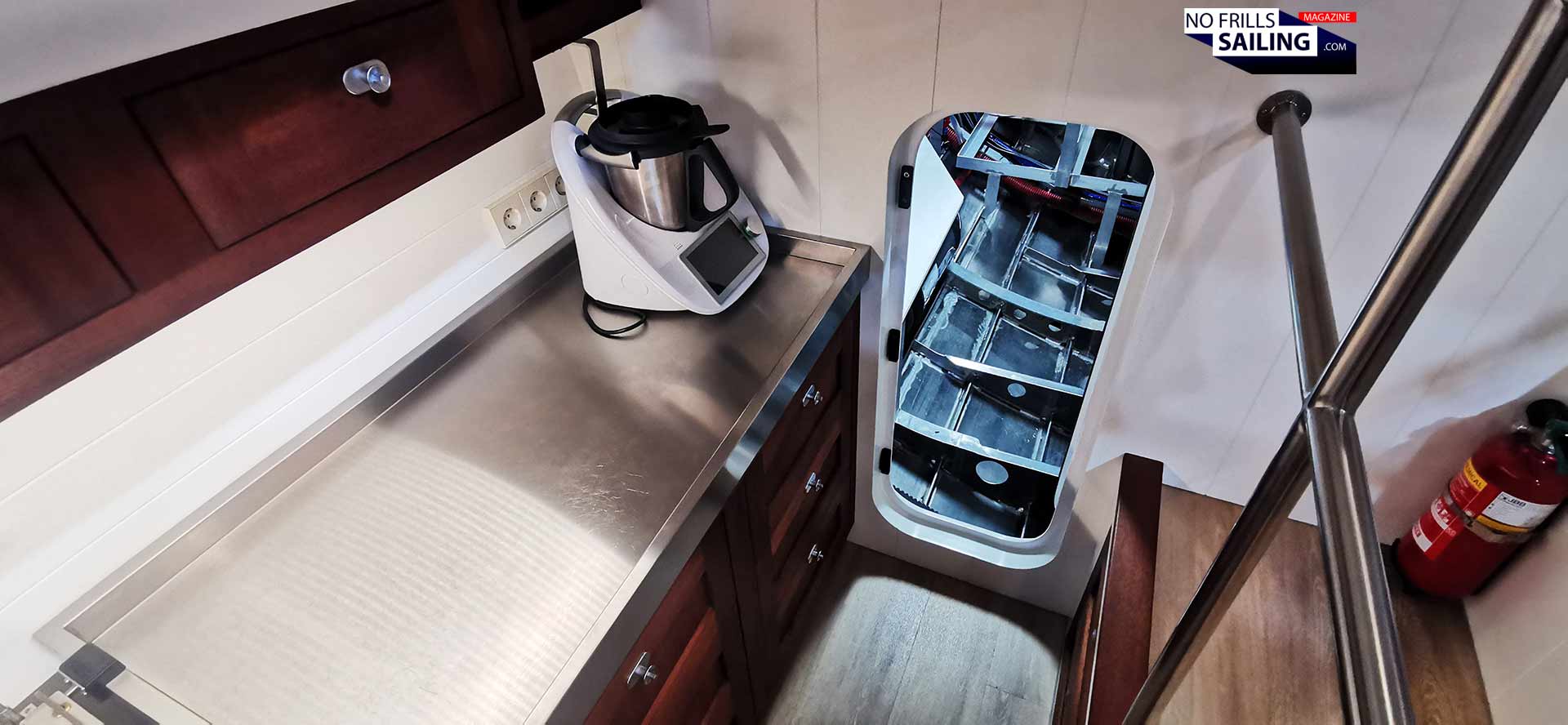
Here in the engine room no insulation, no panels, no decorative facings cover the view to the structure of the boat. Here you can see the stringers, the framework and the nicely rounded aluminium plates which make the hull. Bulletproof in thickness and metallurgic quality, spotless welded together by absolute expert masters of their profession.
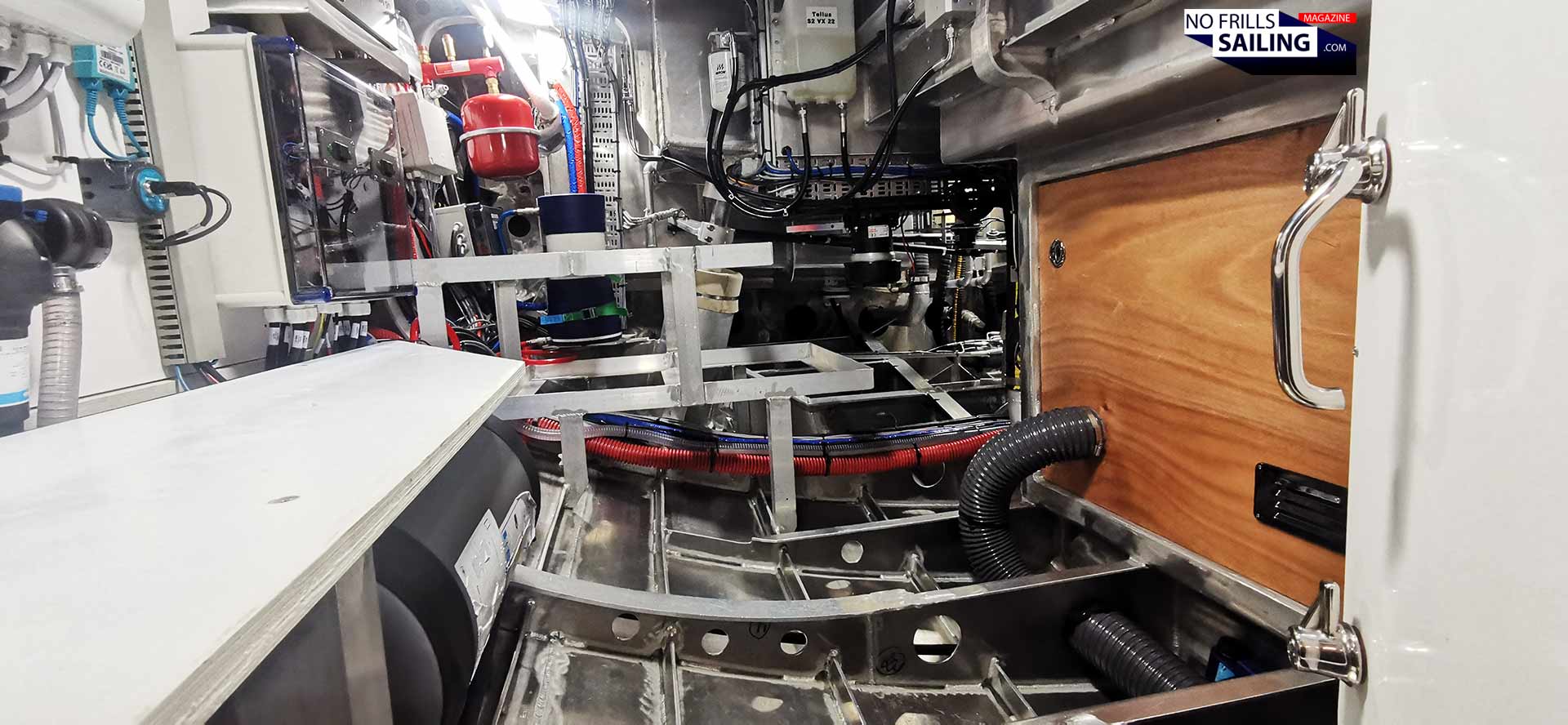
We all know about the pros and cons of the material. Galvanic corrosion as being the most dangerous. All installations must be carried out mass-less, other metals completely shielded and insulated from direct contact. If done properly – as it is the case in this tidy role model yacht – an aluminium hull is a thing of eternity. No wonder why even 15 or 20 years old aluminium-yachts still maintain their high value on the second hand boat market! If kept tidy and maintained properly, this Bestevaer will be around and sailing even when we are long gone.
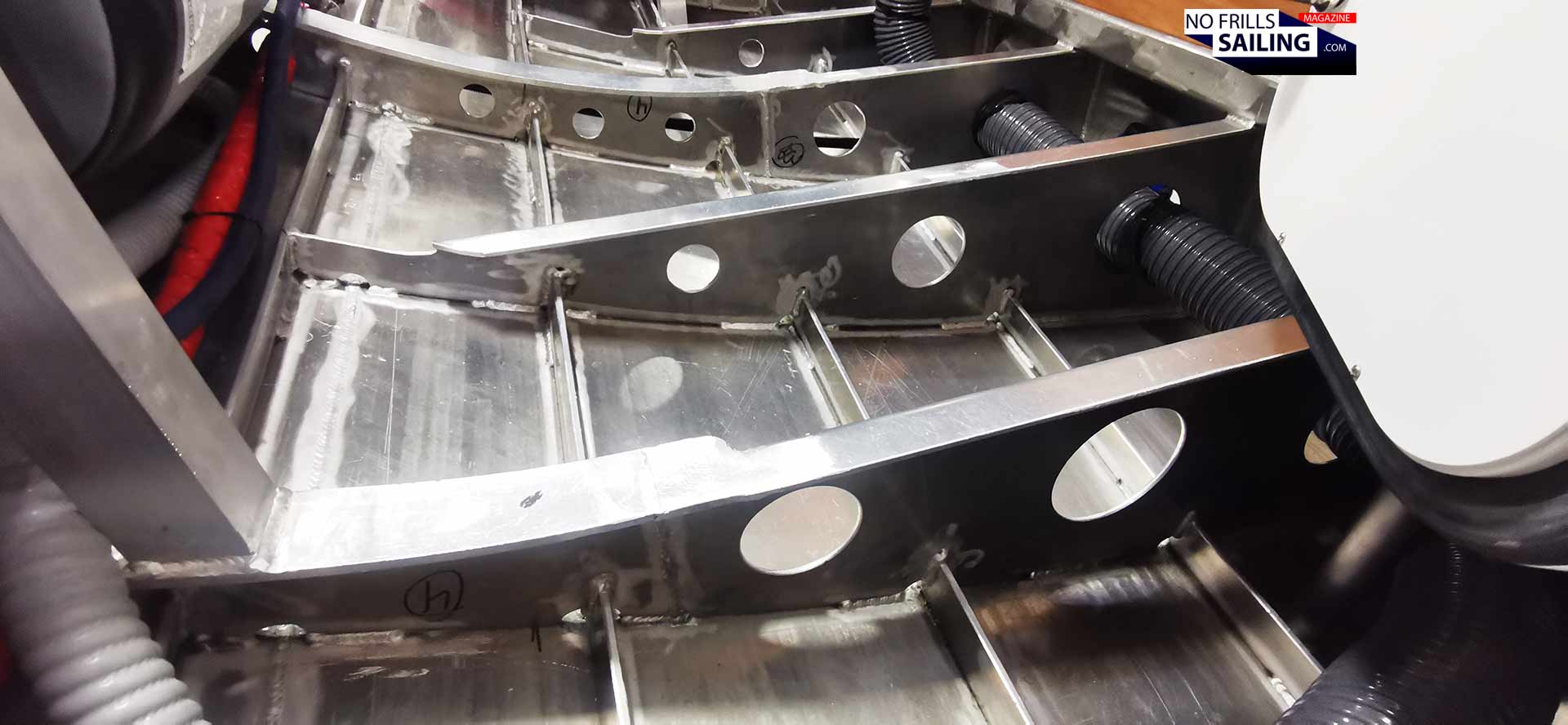
Seeing masterfully crafted boats like this one makes me contemplative: I´ve done many articles on aluminium yachts and I am increasingly interested in modern wooden boatbuilding (LINK) as well. Where GRP helped to „democratize“ and equalize sailing, opening up this wonderful sport for so many people, plastic boats do pose a serious threat to the environment. Compared to such a long-lasting and sustainable yacht like the Bestevaer, any series-production cruiser appears like a single-use plastic throwaway-product. There´s always darkness, where there´s light …
Luxurious sailing couple comforts
Back in the living area of MIC MAC, the most compelling and interesting aspect of this yacht´s interior design choices is the owner´s cabin. Because … there is none. Apparently the owners have decided that there was no need for a separated cabin. As I already pointed out before, the whole approach is to have an „open“ boat. Apparently, this couple sails alone most of the time, so why have closed doors?
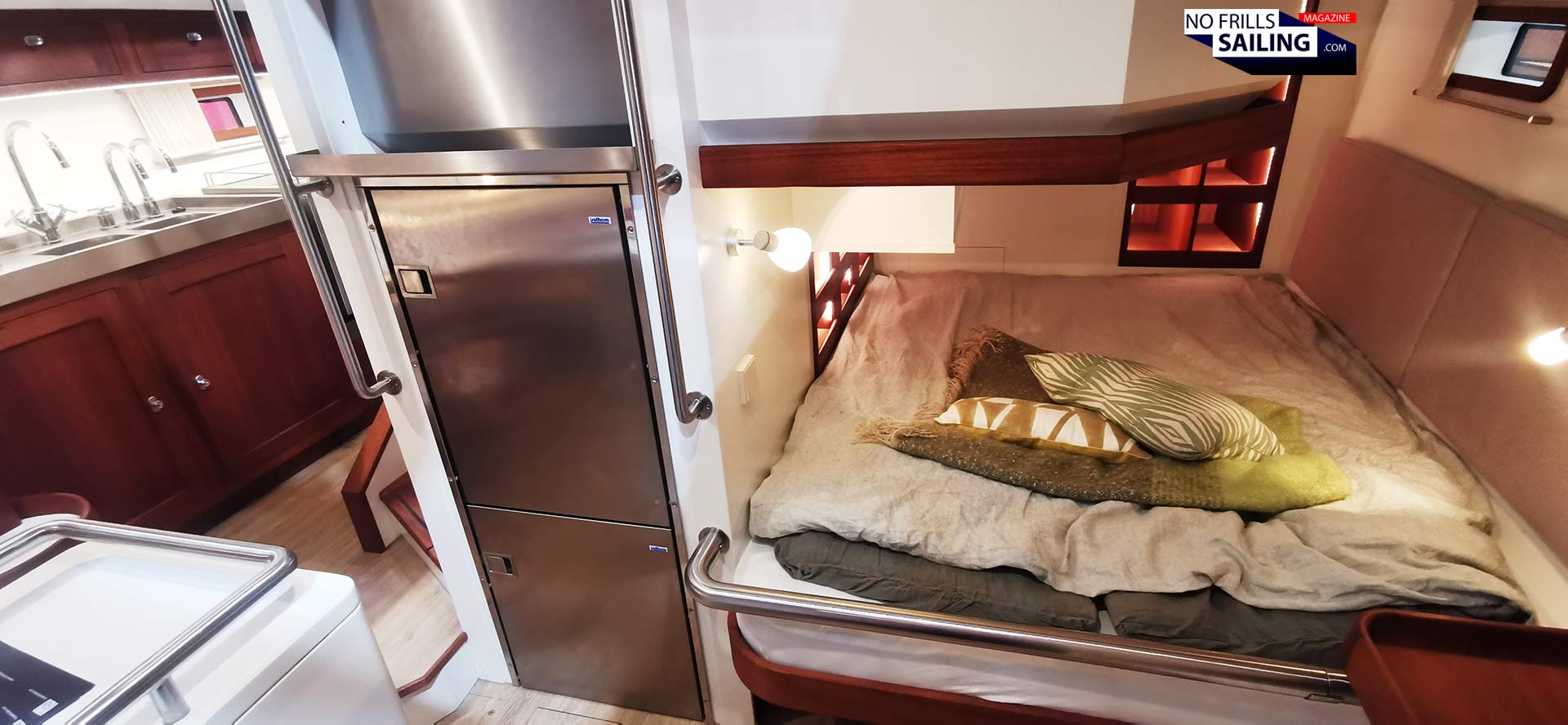
It´s basically the same approach as I had when deciding for the internal layout of my new boat: I went for a „no doors“-concept (except for the head of course) because I too only sail alone, having my kids occasionally with me or – least as possible – some guests. Same aboard this Bestevaer 54: Underneath the doghouse, just „around the corner“ from the kitchen, there´s the big owner´s bed.
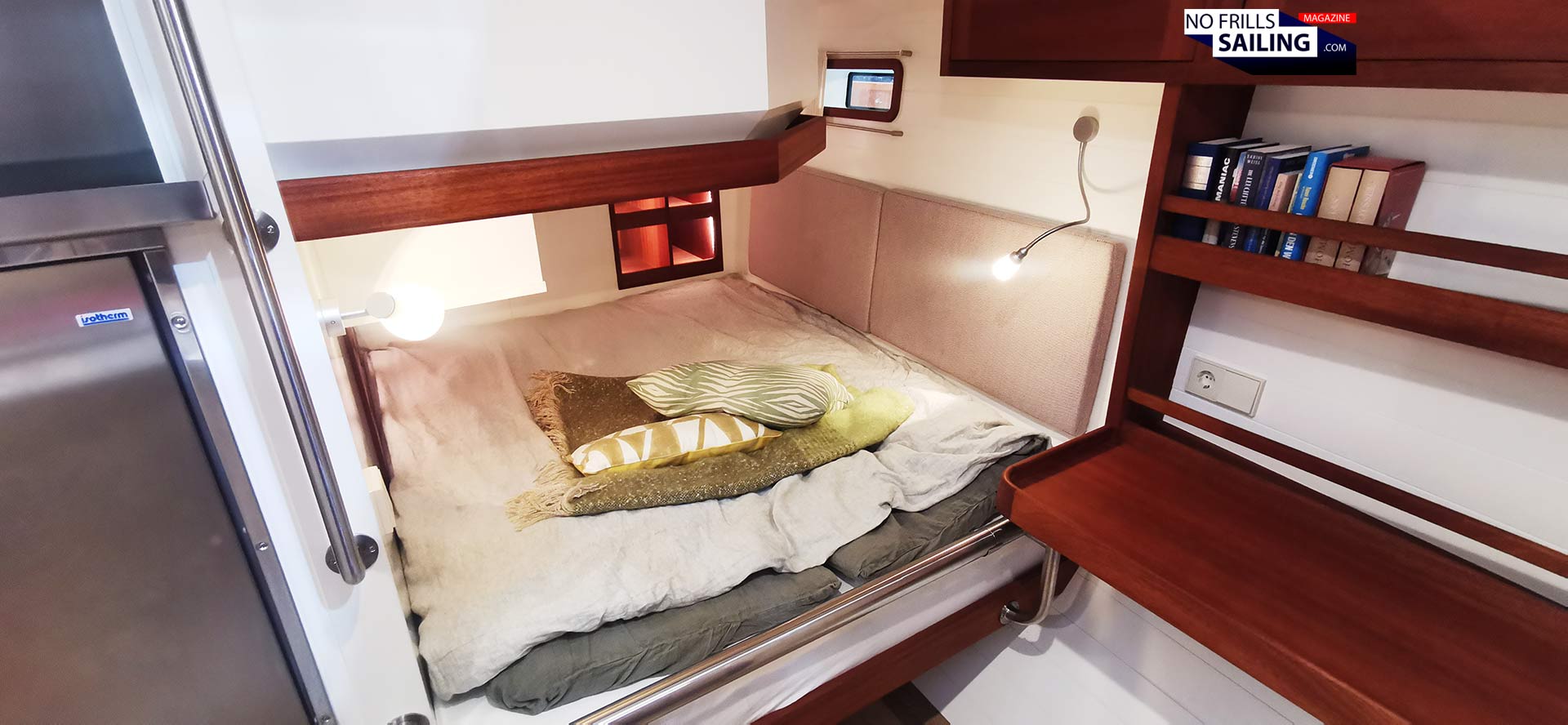
Like a children´s cave, cozily snug into the boat´s side, the owners have a large bed here. It is completely open into the rest of the ship: Fast in, fast out. I would have fitted at least a little curtain to be closed just in case you want to have it completely dark in there, but overall I really love this! Best possible usage of the volume, again, a practical and purpose-driven concept. Just like the rest of the yacht.
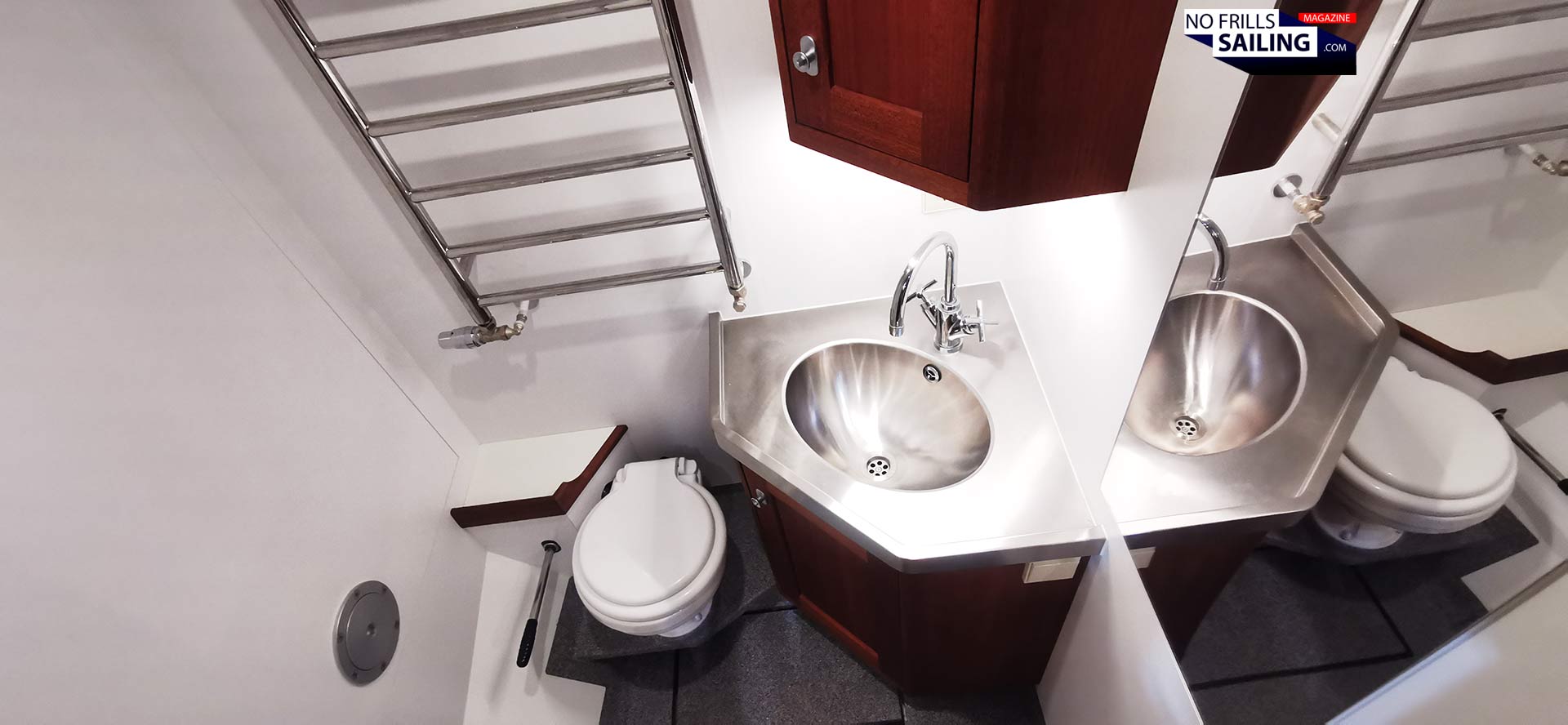
I also like the bathroom of MIC MAC: It is very simple, comparatively small for a boat that size but again, no frills, no „luxury“ decorative elements. You can take a dump in here, wash your body and hang wet clothes to dry out. That´s it. Simple, easy, clean. No waste of precious space or products. And what happens when guests show up? Well:
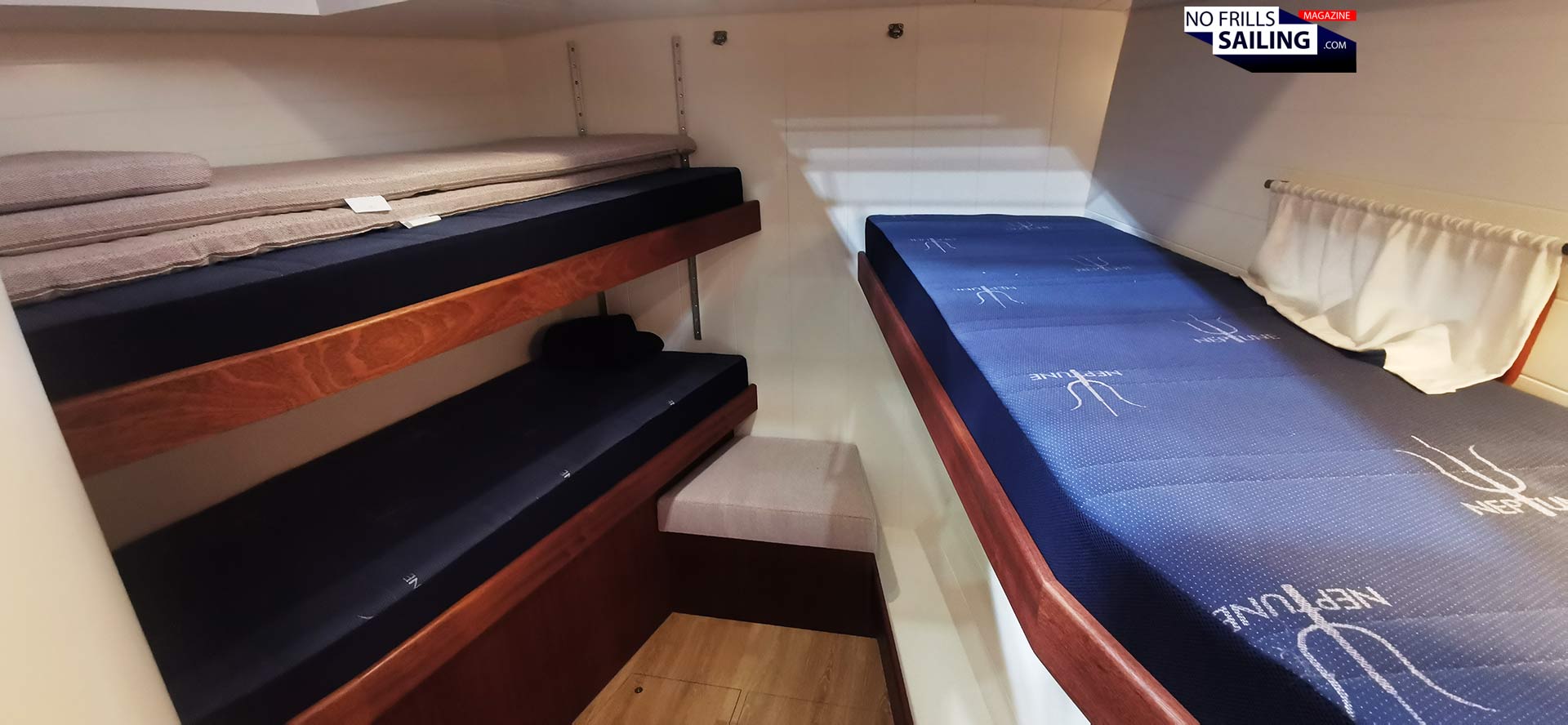
In the mid-section of the yacht there is a large cabin that sports two pullman-style bunks to port side and a single one to starboard side. Depending on the tack, any guest will find a ship´s side to lean into. No frills, no waste material or space. The voyage, the outside, the sailing is the aim, not the self-indulging into lush luxury. That´s a boat made for sailors. This fact becomes clearer by the minute spent aboard.
So, let´s go and get frozen?
Back in the „saloon“, MIC MAC sports another interpretation of the famous „Captain´s Chairs“ which I personally fancy so much aboard the larger Hallberg-Rassy boats. At some point during my refit of the King´s Cruiser 33 I even though of fitting these to my own boat as well. Those are mostly found on „real“ sailing yachts for a dedicated sailing couple, like the Nordship for example. And I was happy to see them aboard the Bestevaer as well.

I can perfectly well imagine myself being down here, in one hand a nice glass of Rum, a book in the other. Spending a calm hour reading and enjoying the fat, moust and saturated heat coming off of the Lofoten Diesel-heating system installed in front of the chairs. Isn´t that the closest you can get to an open fireplace aboard a ship?
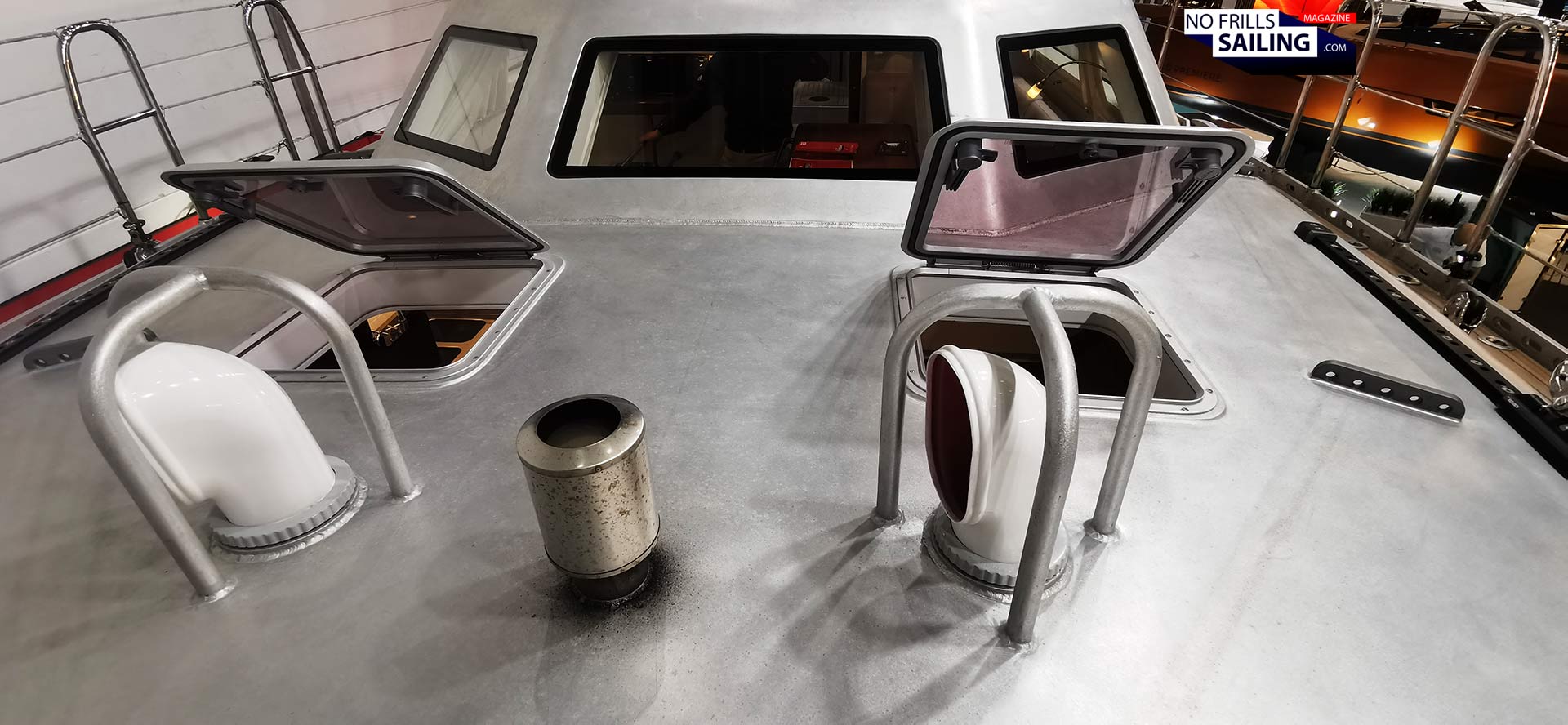
That this oven may be the social center of the owner-couple when moored or at anchor can best be seen up on deck. Where the small exhaust-chimney of the Dickinson Lofoten-oven is situated between two of the beautiful Dorade-ventilators. Now tell me: Isn´t this all the best package you can have to fully disconnect from this wold and get lost in the eternal ice? I´d say so.
Why the Bestevaer remains a cornerstone of exploration sailing
This article turned out to be one of the longer ones. And believe me, there is much, much more to see on this boat! I wanted to start my Boot ´25 retrospective with this yacht because she is so absolutely not what most of the boats exhibited there are: She is a classic, full-fledged offshore yacht made to really conquer the far away, exotic, freezing, maybe hazardous locations of the world. A true go-anywhere yacht.
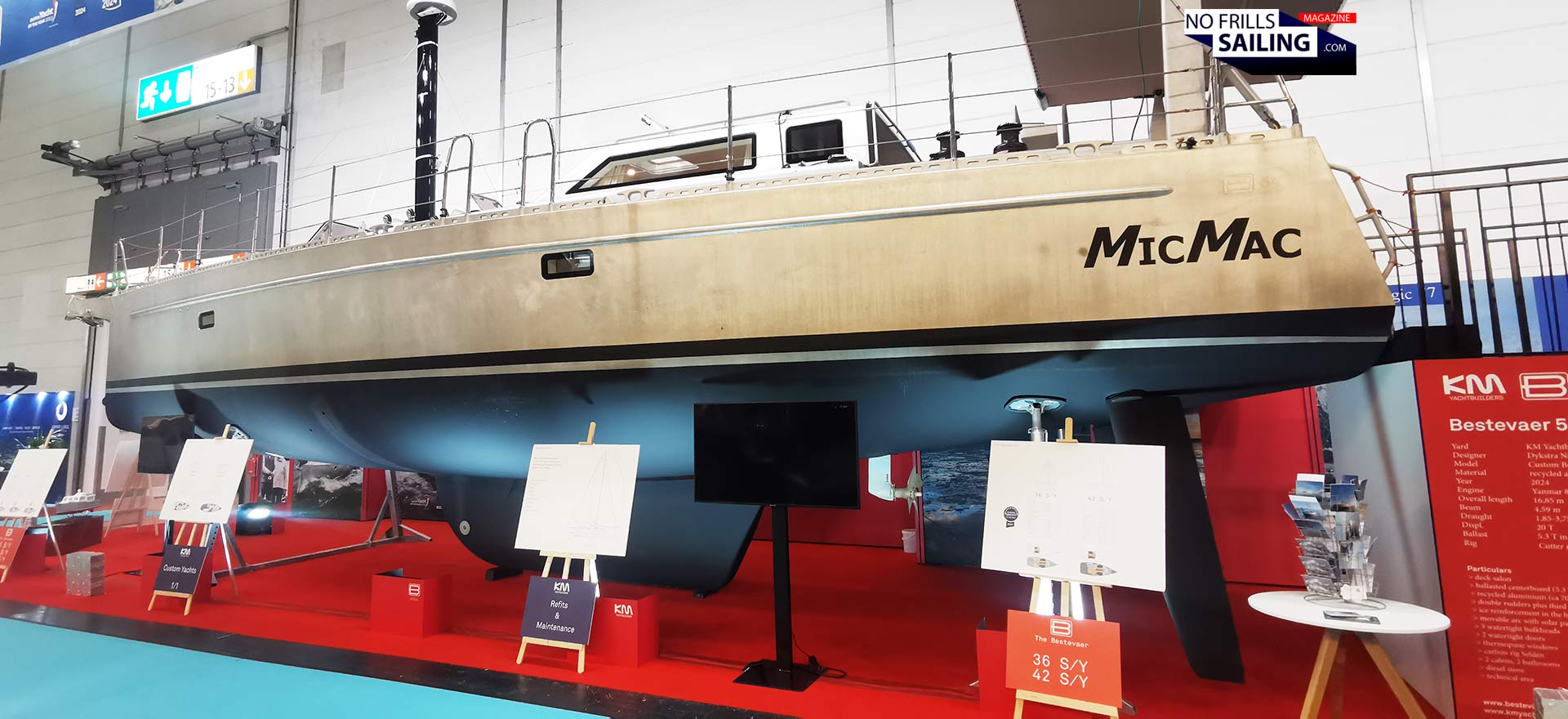
KM Yachtbuilders showcased an absolute jewel of true craftsmanship on the one hand and their core selling point: Making points for special people, to their special needs and briefings. Nothing about the Bestevaer is business as usual, is ordinary or series in any case. It´s a role model for true custum- and purpose-made design. I envy this boat: She is absolutely going to see places, most of us only get to see in books or National Geographic documentaries. Well done, KM, well done, owners!
Connected articles:
Aboard the Bestevaer 55 ST
Aluminium yachts made affordable? The „Pure“-concept of KM Yachtbuilders
All articles tagged with #aluminium
